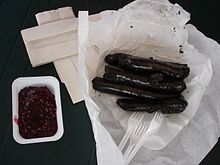

|
No edit summary
|
No edit summary
|
||
| Line 28: | Line 28: | ||
Mustamakkara is known to have been eaten as early as in the 17th century and was generally cooked over a small fire, in a hot cauldron or in an oven. Mustamakkara is made by mixing pork, pig blood, crushed rye and flour, after which it is stuffed into the intestines of an animal like most sausages. The two major producers of this food are Tapola and Savupojat.<ref name = aviisi/> |
Mustamakkara is known to have been eaten as early as in the 17th century and was generally cooked over a small fire, in a hot cauldron or in an oven. Mustamakkara is made by mixing pork, pig blood, crushed rye and flour, after which it is stuffed into the intestines of an animal like most sausages. The two major producers of this food are Tapola and Savupojat.<ref name = aviisi/> |
||
When buying mustamakkara in the Tampere region it is customary to specify the amount of money to spend instead of weight, length or number of pieces. Often people also choose by simply pointing at the preferred piece. The shape and moisture of mustamakkara varies and by this means the buyer can get the piece best suiting their taste. Also common is to indicate purchase of a complete sausage by requesting an "out-and-return" ''menopaluu'' which refers to its U-shape.<ref>{{Cite web|url=https://www.aamulehti.fi/a/23728985|title="Vitosella mustaa" sai väistyä – Mustaamakkaraa tilataan nyt uusilla kokomerkinnöillä|last=|first=|date=2016-06-17|website=www.aamulehti.fi|language=fi|archive-url=|archive-date=|access-date=2018-12-09}}</ref> A traditional location for enjoying mustamakkara is [[Tammelantori]] square in |
When buying mustamakkara in the Tampere region it is customary to specify the amount of money to spend instead of weight, length or number of pieces. Often people also choose by simply pointing at the preferred piece. The shape and moisture of mustamakkara varies and by this means the buyer can get the piece best suiting their taste. Also common is to indicate purchase of a complete sausage by requesting an "out-and-return" ''menopaluu'' which refers to its U-shape.<ref>{{Cite web|url=https://www.aamulehti.fi/a/23728985|title="Vitosella mustaa" sai väistyä – Mustaamakkaraa tilataan nyt uusilla kokomerkinnöillä|last=|first=|date=2016-06-17|website=www.aamulehti.fi|language=fi|archive-url=|archive-date=|access-date=2018-12-09}}</ref> A traditional location for enjoying mustamakkara is [[Tammelantori]] square in the district of [[Tammela, Tampere|Tammela]]. |
||
[[Celebrity chef]] [[Anthony Bourdain]] was one of the celebrities who had given praise to this Finnish [[traditional food]], that is generally divided in Finland, by eating it in ''[[Anthony Bourdain: No Reservations]]'' show for as much as half a pound and saying, "Good stuff!"<ref>[https://www.iltalehti.fi/viihde/a/2012011215067944 AL: Julkkiskokki ahmaisi puoli kiloa mustaamakkaraa] (in Finnish)</ref><ref>[https://www.is.fi/tv-ja-elokuvat/art-2000005713014.html IS: Anthony Bourdain rakastui Suomen vierailullaan mielipiteitä jakavaan perinneruokaan: ”Good stuff!”] (in Finnish)</ref> |
[[Celebrity chef]] [[Anthony Bourdain]] was one of the celebrities who had given praise to this Finnish [[traditional food]], that is generally divided in Finland, by eating it in ''[[Anthony Bourdain: No Reservations]]'' show for as much as half a pound and saying, "Good stuff!"<ref>[https://www.iltalehti.fi/viihde/a/2012011215067944 AL: Julkkiskokki ahmaisi puoli kiloa mustaamakkaraa] (in Finnish)</ref><ref>[https://www.is.fi/tv-ja-elokuvat/art-2000005713014.html IS: Anthony Bourdain rakastui Suomen vierailullaan mielipiteitä jakavaan perinneruokaan: ”Good stuff!”] (in Finnish)</ref> |
||

Mustamakkara with lingonberry jam
| |
| Type | Sausage |
|---|---|
| Place of origin | Finland |
| Main ingredients | pork, pig blood, crushed rye and flour |

Mustamakkara (lit. 'black sausage') is a type of Finnish blood sausage traditionally eaten with lingonberry jam. It is nowadays available in many stores across Finland, but is held in the position of local delicacy and speciality of Tampere, Pirkanmaa. Mustamakkara is at its best when bought and eaten fresh at market stalls, to which it is delivered hot in styrofoam boxes from the factories directly after baking. A typical practice of reheating the sausage is to just fry it in a pan.[1]
Mustamakkara is known to have been eaten as early as in the 17th century and was generally cooked over a small fire, in a hot cauldron or in an oven. Mustamakkara is made by mixing pork, pig blood, crushed rye and flour, after which it is stuffed into the intestines of an animal like most sausages. The two major producers of this food are Tapola and Savupojat.[1]
When buying mustamakkara in the Tampere region it is customary to specify the amount of money to spend instead of weight, length or number of pieces. Often people also choose by simply pointing at the preferred piece. The shape and moisture of mustamakkara varies and by this means the buyer can get the piece best suiting their taste. Also common is to indicate purchase of a complete sausage by requesting an "out-and-return" menopaluu which refers to its U-shape.[2] A traditional location for enjoying mustamakkara is Tammelantori square in the district of Tammela.
Celebrity chef Anthony Bourdain was one of the celebrities who had given praise to this Finnish traditional food, that is generally divided in Finland, by eating it in Anthony Bourdain: No Reservations show for as much as half a pound and saying, "Good stuff!"[3][4]
![]() Media related to Mustamakkara at Wikimedia Commons
Media related to Mustamakkara at Wikimedia Commons
This meat-related article is a stub. You can help Wikipedia by expanding it. |